**Looking for 1st grade literacy block schedules? Click HERE. Or for Kindergarten literacy block schedules, click HERE.**
When I began teaching second grade, I struggled a bit with my schedule. I was moving up from Kindergarten and just wasn’t sure what a daily literacy schedule should look like for second grade.
After some trial and error, I figured out how to structure my literacy block in a way that worked for my kiddos and me. In this post, I’ll share with you the components of my second grade literacy block and some sample schedules.
Before I get started, I do want to say that there’s no one “correct” way to set up your literacy block. The best schedule is the one that meets the needs of you and your students. Also, I love hearing about how other teachers schedule their days, so please comment at the end of the post!
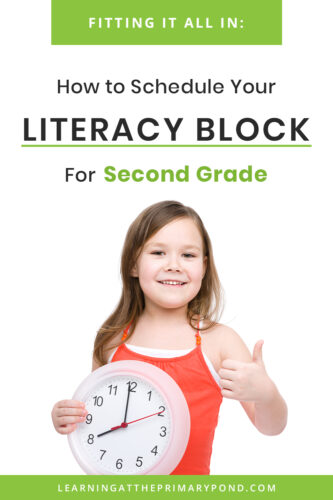
Components of a Literacy Block for Second Grade
Literacy can and should be integrated into all subject areas – it doesn’t have to be restricted to a few hours in the morning! Even so, I did reserve time in our schedule for a dedicated literacy block. Here were the components of the block:
- Shared Reading (can be combined with a reading workshop minilesson)
- Guided Reading or small groups (+ Literacy Centers / Daily 5 activities)
- Readaloud
- Reading Workshop Minilesson
- Independent Reading
- Writing Workshop Minilesson
- Independent Writing
- Word Study / Phonics
Shared Reading (20 minutes): This is when I read aloud a text that students could all see clearly and follow along with. Most of the time I used a grade level appropriate picture book and projected it under the document camera. Students sat on the rug so that they could clearly see the words. Other times, I used a story from the old basal reading series, and students each had a copy of the textbook in front of them. We typically didn’t get through an entire text in a single shared reading lesson. I paused frequently to discuss ideas, comprehension strategies, and vocabulary with students, and I tried to include lots of “turn and talk” opportunities. Click here to read more about the shared reading lessons I use.
Guided Reading / Small Groups and Independent Work (40 minutes): During this block of time, I met with students for guided reading (2 groups total) while the other students worked independently. For my guided reading instruction, I provided students with scaffolding so that they could read texts at their instructional levels (slightly harder than what they could read independently). The students who were not meeting with me responded to the shared reading text in writing. They read or worked on other seat work when they were finished. (Note: your small group reading instruction does NOT always need to be guided reading! There’s also value in meeting with a group of kids to work on a reading strategy, or to support them in reading grade-level, rather than instructional-level, text.)
Readaloud (10-15 minutes): Typically, I read aloud part of a chapter book or an entire picture book to my students.
Reading Workshop Minilesson (10-15 minutes): I taught a decoding, fluency, or comprehension strategy (just one per lesson) that students could apply as they read independently. This was a very brief, focused lesson. I used the book from shared reading to teach the day’s strategy, so that students would already be familiar with the text. (This can also be combined with shared reading if you’re short on time – you can read about combined shared reading / reading workshop minilessons HERE.)
Independent Reading (25 minutes +5 for sharing time): Students read independently, while I conferred with kids individually. Sometimes, I met with a small group of readers who had similar needs. After independent reading time, we came back together as a group, so the students could share about their reading with a partner or the class.
Writing Workshop Minilesson (15 minutes): I taught a brief, focused lesson on a writing (or grammar / language arts) skill that students could use in their own writing. I structured my writing units by genre, so whatever skill I taught was related to that genre.
Independent Writing (30 minutes + 5 for sharing time): Students wrote independently, and I conferred with kids individually. After independent writing time, we came back together as a group so students could share their writing with a partner or the class.
Word Study / Phonics (10 minutes whole group, plus more phonics in small group): I taught From Sounds to Spelling or another phonics program in small groups. I typically met with 1 group per day to introduce a phonics/spelling pattern. At the same time, other students worked independently with their assigned words. It takes some time to set up, but differentiating word study has been super effective with my kids in the past.
Sample Schedules for a Second Grade Classroom
So what would this look like in practice? Below are some sample schedules:
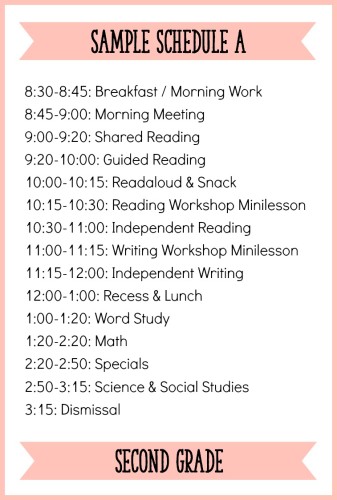
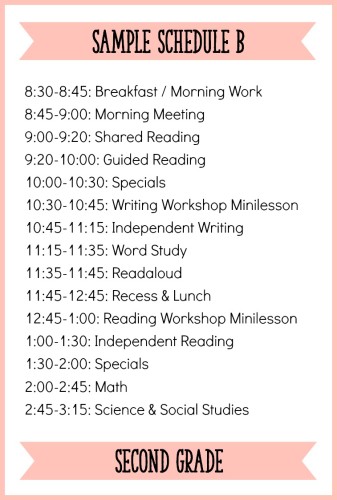
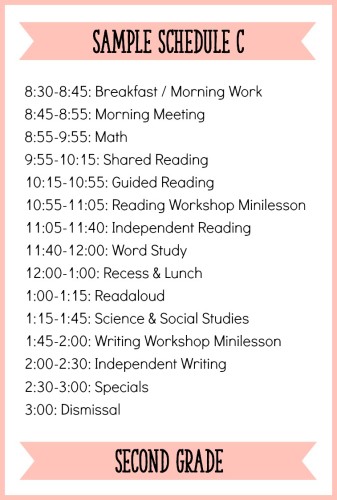
Even though I generally followed one of these schedules, our school day didn’t always look like this throughout the entire year. I love to teach integrated thematic units that engage kids in learning content area material through literacy activities (i.e. reading about and writing about insects). At the beginning of the year, it’s great to establish a routine that provides kids with consistency. But as the year goes on, I think it’s completely fine to deviate from that schedule. Literacy learning doesn’t always fit nicely and neatly into a box!
I hope this post gave you some ideas about how to schedule your literacy block in second grade! If you’re looking for literacy lesson plans to cut down on your planning and prep time, click on any of the following images to find out more:
 https://www.fromsoundstospelling.com/
https://www.fromsoundstospelling.com/
Happy teaching!


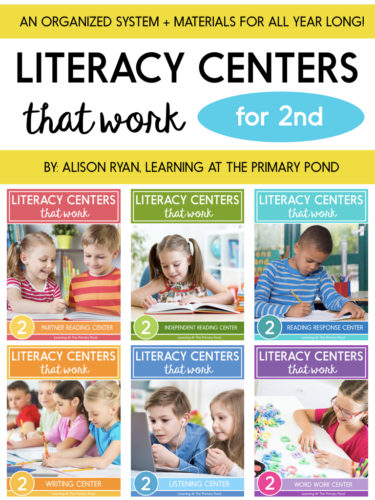
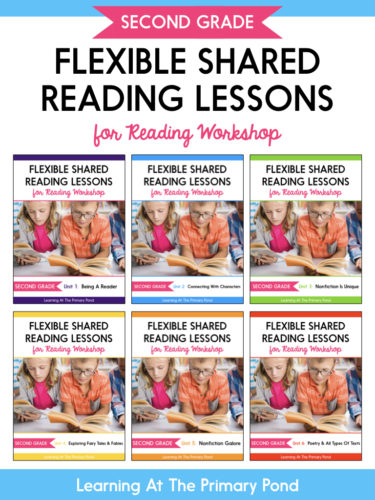
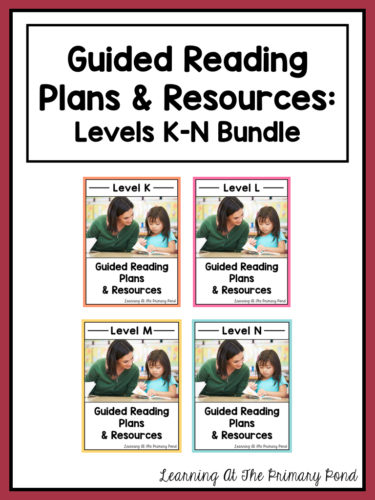
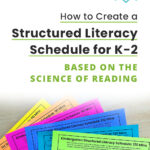

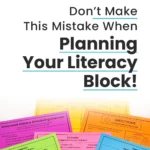
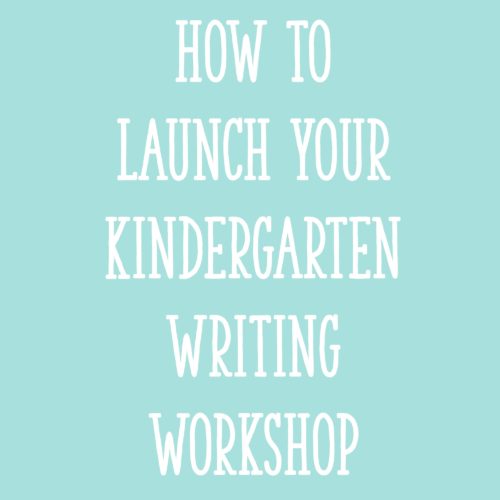
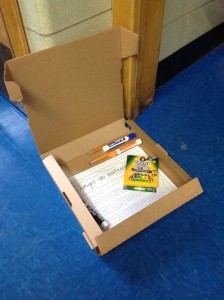
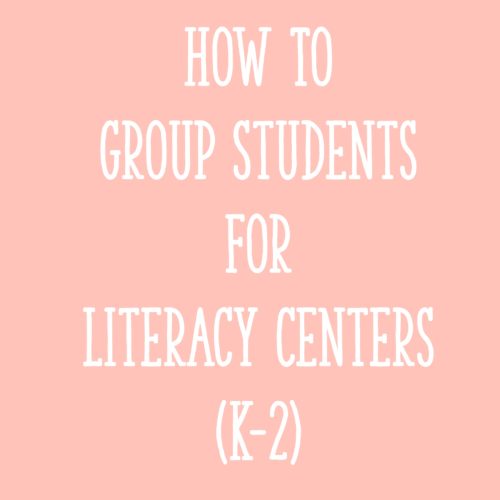






Thanks for this info. I’m moving from 5th to 2nd and feel overwhelmed when it comes to our literacy block. These are great ideas that I plan on using.
Take care and have a great school year,
Annamarie
I hope this helps, Annamarie! Good luck with your transition!
Alison
Did you end up liking second grade?
Thank you. YOur post was vey helpful. Could you share how you write out your plans? What does your lesson plan look like?
Hey Donna! Which plans were you talking about – shared reading, guided reading, or something else? For the most part, I just list the objective, standard, text, and then use bullet points to list what I’ll be doing in the lesson. When I rewrite the lessons to share with other teachers (see the links in the post), I do write out in more detail what I do and say during each part. Not sure if that answers your question, but feel free to email me if it doesn’t! 🙂
Alison
I love your blog and these sample schedules are wonderful. My school has been implementing RTI for the past two years and that is such a big part of our day, 1 hour! Our school uses a “walk to” model where the entire grade level switches classes during the time our Tier 2 and Tier 3 students are receiving their intervention. Because this takes up such a big portion of our day, we are having a hard time getting in all of these critical components of reading. Do you have any suggestions for creating a schedule? We have from 1:35pm-3:25pm… Read more »
Hi Jordan! I have been in a similar situation where the school had 30 minutes for interventions or enrichment for literacy, as well as 30 minutes for interventions or enrichment for math. That seems like a short time to teach all of those subjects! Is the whole morning taken up by math and the RTI block you mentioned? When I had limited time, I created a schedule that alternated days rather than stayed the same on each day. For instance, on some days we maybe only had 15-20 minutes for writing, but I would set aside time so we could… Read more »
I was asked at an interview: “if we had a 20 minute interruption of the school day during your literacy block, what would you eliminate and why?” It’s been eating at me ever since…how would you answer that one? Just curious about others’ thoughts!
That’s a really good question! I would probably respond that I’d eliminate some part of teacher-driven instruction. I consider student practice (with teacher support and guidance) to be one of the most important things that moves kids forward, so I would eliminate something other than independent reading, guided reading, or independent writing time. How did you respond?
Alison
Hello! Thanks for the great info. You mentioned that your word study activities were effective but hard to set up. What activities were these?
Hi Alison! I love your breakdown of each of the components of the literacy block. I wish I could do all of it every day! We went to departmentalization last year with 3 teachers; so as the ELA teacher with three 90-minute classes, that doesn’t leave enough time for everything! Can I pick your brain for a schedule that would work in my situation? This of course means that I would not do everything, every day. I should also let you know that I am Orton Gillingham-trained and love doing that as a whole group lesson. I also love the… Read more »
Hi Theresa! Departmentalization can be tricky – I’ve been in a similar situation. I think you are so right that you can’t do everything every day! Maybe some days you could spend more time on phonics/grammar, and then other days spend more time on writing. My must-haves for each day would be readaloud, shared reading, independent reading, guided reading/individual conferences, and some kind of writing. 🙂
Alison
Thank up for this. I am moving to second grade this year and feel a little overwhelmed. The only major thing I struggle with is that we have 30 of mandated intervention time and it seems that some things have to be pushed out due to this. We switch kiddos between classes and by the time we are all back together we have lost almost an hour total.
Hey Kendra! I have been in a similar situation – we had 30 mins of mandated intervention time for reading AND 30 mins for math! In this case, I wasn’t doing the schedule exactly this way. I saw fewer reading groups during “regular” reading time, because I knew kids would be seen in small groups during the intervention time. I just had to keep in mind that even if I couldn’t fit in all of the instructional activities I wanted during the normal reading block, kids were getting more individualized attention during that intervention block. Beyond that, maybe talk to… Read more »
What are your suggestions for independent work that is done while working with guided reading groups?
Hi Mikayla! I have a whole post with suggestions here: https://learningattheprimarypond.com/blog/meaningful-centers-ideas-for-kindergarten-first-grade-and-second-grade/
🙂 Alison
Hey , I wanted to say how much I absolutely love you lessons and tips. I am first year teacher and have been struggling to get my literacy block sorted out! I am having a bit of difficulty with shared reading however.. I would love to implement the methods you use however my school asks that we stick to the basal readers for shared reading and I cannot always apply the lessons to them. What would you recommend so that I can keep shared reading concise, but effective using the system they have?
Hi Caitlin! I have used a basal for shared reading, too. We would just get through part of the story each day, and we wouldn’t really do all of the “extras” that the basal has. I just choose one main teaching point and try to stick to that, and then implement shared reading as usual. I’m not sure if you’re using my shared reading series, but if you are, you can always rearrange the weeks and use the basal story or stories that best fit with the strategy. Would that work with your requirements? I hope your first year is… Read more »
I was moved to a magnet program within our public school that is language immersion as soley the reading teacher. I am only allowed to teach 90 minutes of ELA (me)and the other 90 min must be in the target language (french/spanish teacher) and have 2 reading programs (one phonics and one is a state mandated read aloud curriculum) and am required to do small groups and see every group, every day. I am struggling with fitting it all in!!! I used to see just 3 groups a day for 15-20 minutes each and now its daily for 12 minutes… Read more »
Hi Kristy! You definitely have a time crunch there! I’m planning a longer post on this topic (trying to fit everything into your literacy block when you have limited time) for December 3rd. Maybe other readers will have better ideas, but I wonder if you could alternate activities with an A Day/B Day schedule? For example, you could spend more time on word study one day and more time on vocabulary another day? I’ve found that trying to do fewer things for longer chunks of time helps a bit!
Alison
That is a nice idea! Yeah, this year I knew would be kind of crazy trying to figure out what will work best. I appreciate your input a lot! Thank you. 🙂
-Kristy
I only have 90 minutes per day for L.A. in a grade 2 class. Any suggestions for scheduling?
Hi Kristin! This post might help 🙂 https://learningattheprimarypond.com/blog/what-to-do-when-you-cant-fit-all-of-the-balanced-literacy-components-into-your-literacy-block/
Alison
Where do your literacy centers fit in which this schedule?
Hi Kayla! My students do literacy centers while I am pulling guided reading groups. It’s their independent work. 🙂
Alison
We are required to have at least 9 summative grades each quarter for language arts and reading. With your shared reading, reading workshop, and writing workshop, how would you do that? I am having a hard time. Thanks!!
Hey Abby! This is a great question! In a nutshell, I use observational rubrics and checklists and convert those scores to grades. If you email me at Alison@learningattheprimarypond.com I’d be happy to give you a more in-depth answer! 🙂
Alison
Hi there! This looks great! As a 3rd grade teacher who struggles with fitting it all in, would you say this type of system could work with 3rd grade? I only noticed you had k-2. What suggestions do you have for the higher elem. grades?
Hey Natalie! I am not super experienced with the upper grades, unfortunately. I think that many of the balanced literacy elements would stay the same, but the instruction and activities might look a bit different.
Alison
Hi Alison!
My school tries to incorporate 70 minute small group time (this includes 30 minutes of mandated RTI)…technically this leaves me with only about 1 hour and 15 minutes to get in reading, word study, and writing whole group. Would you consider alternating reading and writing weekly? I feel students need at least 45 minutes of writing time but trying to squeeze both reading and writing every day makes lessons seem short and unproductive. Thoughts?
Hey Erika! That is definitely a time crunch! I’m not sure that I would want to go entire weeks without writing instruction – but maybe A days / B days would be another option? Check out this post, too! https://learningattheprimarypond.com/blog/what-to-do-when-you-cant-fit-all-of-the-balanced-literacy-components-into-your-literacy-block/
Alison
In our building (a priority school) we have designated times to do each of the components. The areas and times are very similar to yours. Unfortunately, it is sometimes difficult to keep to such a rigid schedule. Sometimes students have meltdowns, some come in late, interruptions from the office. It is frustrating at times.
So true! I try to be okay about letting go, because I get a little stressed out when we can’t stick to the schedule! Just doesn’t always work that way when we’re teaching real kiddos!
Alison
Alison,
Are the shared reading, read-aloud, minilesson, and word study conducting in a whole group setting? Wondering how your Balanced Literacy Block would work with our schedule …
Our “reading block” is to be 90 minutes meeting with intervention/below level small groups every day; staggering on-level and exceeding groups every other day. While groups are meeting with me, Daily 5 is happening with the rest of the class and they move through 5 centers.
Hi Kathleen! Yep, I do shared reading, the readaloud, and minilesson whole group. You can definitely combine the shared reading and minilesson to save time. I generally teach word study in small groups.
This post might also be helpful: https://learningattheprimarypond.com/blog/what-to-do-when-you-cant-fit-all-of-the-balanced-literacy-components-into-your-literacy-block/
Alison
Can the Shared Reading Lesson Units stand alone or do they have to go hand and hand with Reading Workshop Units?
Hey Marshella! I know we’ve been in touch via email, but they can stand alone. 🙂
Alison
Do you know of a similar resource I could share with grades 3-5 teachers? They keep asking how to fit it all in. Thanks! Amy
Hi Amy! I’m not sure I know of something; sorry about that!
Alison
Help! I have a 70 minute reading block. Any schedule suggestions?
Maritza, is that 70 minutes for all of your reading and writing instruction? Or is it separated?
This was super helpful. This is my first time teaching grade 2, and I’m doing it 100% virtually and have been struggling to find the right rhythm and set up for literacy. I only have 100 minutes of literacy a day with my kids, but I feel like I have a better handle on what to include and how to structure it 🙂
I’m so glad that you found this information useful, Nicole! Teaching a new grade for the first time has its challenges, but doing it 100% virtually adds another element to it as well! Hopefully you are able to incorporate these tips into your schedule to make the most of your time. 🙂